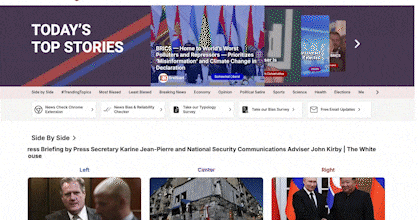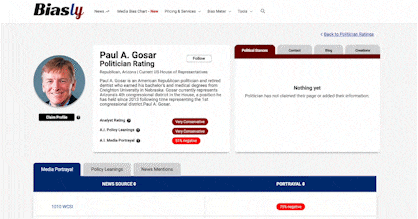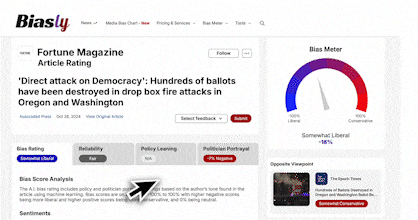
According to the About Us section of IJR.com, “Founded in 2012, Independent Journal Review (IJR) is a news site that provides readers with reliable information about both sides of every issue. IJR also invites readers to experience the news through a blend of products and services that enable them to actively participate in story selection, development, and promotion. IJR is headquartered in Alexandria, VA.”
Pew Research Center’s data shows that 19% of IJR.com’s audience identified a Liberal Democratic or lean democratically and 33% identified as Conservative Republican lean more Republican.
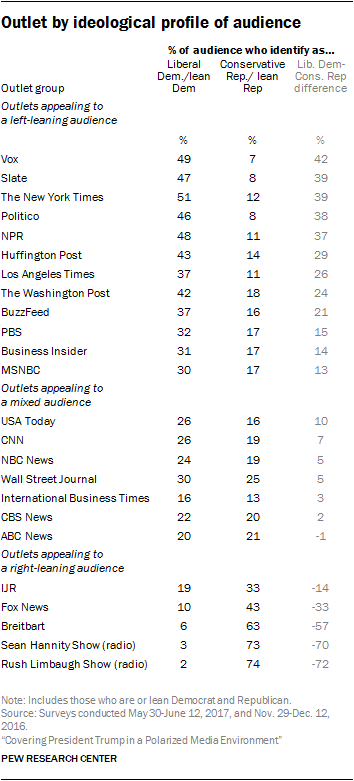
Source: Pew Research
How Does Biasly Rate News Sources?
Biasly’s algorithms produce bias ratings to help provide multiple perspectives on given articles. Biasly has analyzed 200,000+ news articles from more than 3,200 news sources through our A.I. technology and team of political analysts to find the most factual, unbiased news stories.
Biasly determines the degree of political bias in news sources by using Biasly’s Bias Meter Rating, in which Biasly’s team analyzes media sources’ reliability and bias and produces three scores, a Reliability Score that measures the accuracy of media sources; an A.I. Bias Score, evaluated by A.I.; and an Analyst Bias Score evaluated by political analysts. These scores are rated based on seven rating metrics including Tone, Tendency, Diction, Author Check, Selection/Omission, Expediency Bias, and Accuracy. These metrics help our analysts to determine the political attitude of the article.
Our A.I. machine-learning system employs natural language processing and entity-specific sentiment analysis to examine individual articles and determine their bias levels. By analyzing the key terms in an article such as policies, bias phrases, political terminologies, politicians, and their nicknames, the algorithms can rate the attitude of the text. Bias scores range from -100% and 100%, with higher negative scores being more liberal and higher positive scores being more conservative, and 0% being neutral.
Is IJR.com Politically Biased?
IJR.com is a relatively new media source, only coming into being in 2012. Despite being young, the Independent Journal Review has been praised by different sources and organizations, including the Trust Project and Santa Clara University.
Biasly’s rating for The Independent Journal Review is based on two scores, one from its computer algorithms which are based on A.I., and one from its Analysts. Biasly rated the New York Times with a Computer bias score of Moderately Conservative and an Analyst bias score of Center, which means, overall, it is possible to see political coverage from an American conservative political perspective. Analyst scores are based on an average of at least 15 articles with each being reviewed by one liberal, moderate, and conservative analyst. The more articles rated by Bialsy’s analyst team for a particular source indicates a more accurate analyst score. As Biasly rates more articles, the scores will become more accurate. Praise for conservative politicians and policies as well as dislike toward Democrat policies and politicians contribute to this rating.
Readers like you are more likely to have a strong opinion of the IJR based on your political leaning because they tend to favor conservative causes and people as represented by Biasly’s “Moderately Conservative” rating. In the remainder of this article, we’ll talk about ways to identify this bias so you can separate the opinions from the facts and become a more informed consumer of news.
Before we begin, we need to discuss bias. Bias is a natural function of humans, and we can express it both consciously and unconsciously. Bias is one of the most fundamental forms of pattern recognition in humans. This isn’t to lower the bar and say that “all things are biased,” but to explain the process in which we may come to trust certain news organizations that display patterns of coverage.
On the media’s part, there is an incentive to retain audiences, encourage them to purchase subscriptions, and rate products positively. Bias is a two-way street, people want to see news stories about things they care about, and the media needs viewers to continue their operations. This creates a positive feedback loop that influences what stories are covered and from what perspective. This also explains the actions of more liberal news organizations.
Analysis of Bias in IJR.com Articles
When determining bias, some of the most common metrics used include Tone, Author, and Diction, which are the primary metrics we’ll focus on below. Tone refers to the attitude of the writing and is related to but distinct from diction, which is the writer’s word choices. The Author metric refers to the author of the article and his or her demonstrated stance on issues through past articles and social media posts.
The first article we will examine is “Kari Lake Shares Whether She Is ‘Entertaining’ Running for Senate in 2024”. Biasly has rated this article as “Extremely Conservative” on the bias meter. Part of the reason for this rating is that even though the author, Bradley Cortright, tried to maintain neutrality, the tone suggests that he has negative views about Kari Lake.
The tone is made clear from the beginning when the author said:
“Failed Arizona gubernatorial candidate Kari Lake may be considering running for office again. “
An underestimation is visible in that statement as Kari Lake cannot win the presidency since she could not win before. Once he covers Lake’s view about running for the office again, the author then uses the following sentences:
“She would either have to admit she lost the election fair and square and look like a fraud and a sore loser. Or she will have to come up with some way to explain why they can trust their votes will matter this time.”
Even though the diction of the article is not extreme, it criticizes Kari Lake and her attitude now and in the past about the election. For example, the author uses the word “failed” to refer to the previous election loss.
In the article, the author does not refrain from gathering quotes from conservatives who are not in favor of Kari Lake’s running for office. For instance, conservative commentator Charlie Kirk says that some conservatives are “clamoring” about Lake’s run for Senate. The author excludes positive perspectives towards Lake. The only positive sentiment about Lake is when the author says:
“As a candidate, she had charisma and seemed to capture some of the energy former President Donald Trump brought to the campaign trail. She was also excellent at creating viral moments on social media of her dealing with the press. “
This quote contributes to the neutrality, despite negative sentiments throughout the article.
To sum up, the author strives for objectivity for the most part and provides select perspectives from sources that don’t favor Kari Lake’s candidacy, but he ultimately spins the story to support one side. All of this suggests that, while some elements of this article were neutral, the article was found to be right-leaning overall, which aligns with our analysis of the IJR as a company with a tendency to lean right in its biases.
Although this article falls on the right end of the spectrum, article bias can differ between articles and authors, even when they come from the same organization. This shows the importance of looking for the signs of bias — including (but not limited to) tone, diction, author, and omission bias — in any article you come across.
Another article, labeled as a Commentary piece, is entitled “Manchin Reportedly Proposed Slashing Dems’ Spending Package by $2 Trillion in July.” Biasly’s A.I. rating is “center,” and the author refrains from emotionally loaded language or words that can affect the readers. The article informs the readers and displays the facts objectively by avoiding personal opinions:
“Additionally, the West Virginia senator proposed raising the corporate tax rate to 25%, the top income rate to 39.6%, and the capital gains rate to 28%. It also said that any revenue “exceeding $1.5 trillion” would be used for “deficit reduction.”
The article shows a good example of an unbiased piece. Even in the title, it is visible that the author will provide objective facts from a non-partisan view.

So did Robert E. Lee’s father. https://t.co/qhPBgMrdgW
— Bradley Cortright (@bradmcortright) February 28, 2024
Wow you really owned the conservatives here https://t.co/fcueYx0sfE
— Bradley Cortright 🇺🇸 🇮🇱 (@bradmcortright) February 27, 2024
Analysis of IJR opinion articles
Before we answer this question, we need to distinguish between opinion and reporting. While reporting is intended to be neutral, giving the reader the facts and quotes from primary sources to let them form their own opinion, opinions are an outlet for columnists to express their personal views on the issues of the day. While we saw elements of factual reporting in the analysis above, the IJR opinion pieces don’t seek objectivity but prioritize putting forth an opinion instead.
Consider the opinion article “Biden Earns New Nickname for How Terrible of a Liar He Is”
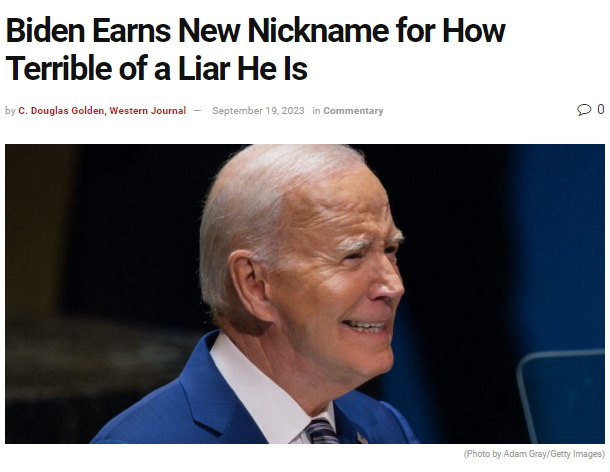
“It’s certainly not an inapt moniker. Biden has long been an out-and-out liar, but the establishment media have tended to cover for him in various ways.”
Throughout the article, the author does not refrain from using harsh words which can damage the objectivity and neutrality of the article. Despite some objective facts in the article, the apparent bias in the title and judgemental language implies that the author does not intend to provide a fair and objective reporting of the facts.
Nevertheless, the article “White House Announces Biden Will Veto GOP Bill That Includes Military Pay Raise If It Passes” has an objective title that aims to inform the reader about the issue. In the title, the author avoids using emotional sentiments or words that can direct the readers to a political agenda. Reliable articles marked by neutral language and facts from credible sources. Based on the title alone, it could be safely assumed that this article would be less biased than the previous one.
These articles, in addition to those above, are only a small representation of all of the IJR content, but they indicate that the outlet is often characterized by a great deal of opinion — further underscoring the importance of knowing how to distinguish subjective writing from genuine reporting.
Who Owns The Independent Journal Review?
IJR was founded by Alex Skatell in 2012, who is the CEO, with Camden Stuebe as President and Shushanna Walshe. Though his political affiliation is not stated outrightly, he was a former digital director of the National Republican Senatorial Committee. Also, he thought there was a lack of publications that would suit the mainstream center-right audience in the market. Therefore, he gathered news stories on a Facebook page called Conservative Daily and later launched the Independent Journal Review.
How to Evaluate and Uncover Bias
It can often be difficult to tell if the news you watch is biased. If you have settled on a news channel, it’s usually because you trust the information you are gaining. Unfortunately, many trust the information they are hearing because it confirms what they already believe. This is referred to as “confirmation bias.” It is important to challenge your beliefs and get third-party verification that what you are hearing is the full story. This is why we recommend using Biasly to compare different news stories side-by-side using our bias ratings to figure out what both sides think of a political issue.
Bias as rated IJR.com as Moderately Conservative and it is important to keep that in mind when selecting a news source or articles. Additionally, some article types will inherently have more or less bias; general news articles are known for being less biased than opinion pieces. Articles may contain language that is used to show bias and one might not even notice it. And while every article you read will be biased to some degree, some stick to the facts better than others, which is why it’s so important to use Biasly’s News Check to help you determine the bias of what you read.






















